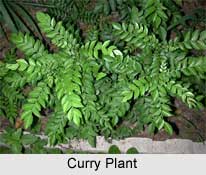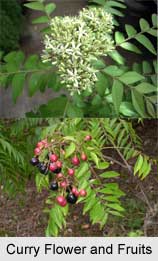 The curry tree is a tropical to sub-tropical tree in the family "Rutaceae", which is native to India and Sri Lanka. The plant is cultivated throughout India and in the foothills of Himalayas and in many cases it is used to flavour curries. Its leaves are used in many dishes in India and neighbouring countries. Often used in curries, the leaves are generally called by the name "curry leaves".
The curry tree is a tropical to sub-tropical tree in the family "Rutaceae", which is native to India and Sri Lanka. The plant is cultivated throughout India and in the foothills of Himalayas and in many cases it is used to flavour curries. Its leaves are used in many dishes in India and neighbouring countries. Often used in curries, the leaves are generally called by the name "curry leaves".
The curry leaves are used extensively in South Indian and Sri Lankan cooking, especially in curries. Although thrown out later, the curry leaves are essential in providing the rich aroma to the curries. Recent studies have shown these leaves to possess anti-diabetic, antioxidant, hepatoprotective properties. They are also good for hair.
Different Names of Curry Plant
Curry is an Indian medicinal plant, the scientific name of which is "Murraya koenigii (L.) Spreng". In languages like Bengali, Hindi, Kannada, Malayalam, Marathi, Oriya, Punjabi, Sanskrit, Tamil and in Telugu it is respectively known as "Barsunga", "Barsanga", "Gandhabevu", "Kariveppu", "Gandla", "Basango", "Bowala", "Kaidaryah", "Karivevempu" and "Karepahu".
 Characteristic Features of Curry Plant
Characteristic Features of Curry Plant
The curry plant is a large shrub or small evergreen or deciduous tree to 5 m tall with a short trunk, thin, smooth, grey or brown bark and a dense, shady crown. Most parts of the plant have a strong, peculiar smell. The leaves of the plants are pinnately compound and are arranged spirally, crowded on the ends of branchlets. Flowers are white in colour. The lobes are triangular and sub-acute. The fruits (berries) are ovoid to sub-globose, wrinkled or rough with glands, to 2.5 cm long and 0.8 cm in diameter, purplish-black when ripe. The fruits are 2 seeded. The plant flowers mainly between February and April, and the fruits are seen between April and August, depending on locality.
Medicinal Values of Curry Plant
Curry leaf has many medicinal properties. It stimulates digestive enzymes and helps break down food more easily. It is also a good remedy for nausea and indigestion. The leaves of Curry plant are also used as an herb in Ayurvedic medicine. They are believed to possess anti-diabetic properties.
Curry leaves have plenty of Vitamin A and calcium. The calcium content in curry leaves help in strengthening the bones. Curry leaves take care of indigestion, stomach ulcers due to excessive acid secretion in stomach, diarrhoea and other similar problems. It also prevents deposition of fat in various parts of the body. It is also taken as a remedy for vomiting, diarrhoea, bloated stomach etc. A paste made of curry leaves is applied on boils and skin eruptions for quick relief. Curry leaves are known to be effective in treating premature greying. Eating the leaves helps in strengthening hair roots.



















